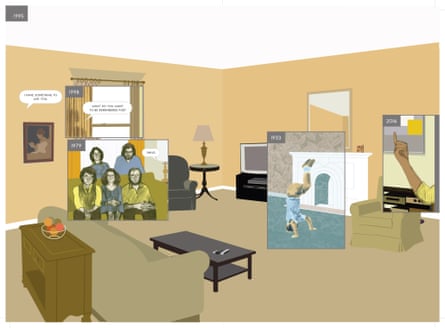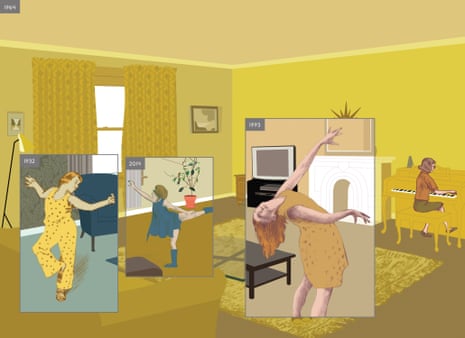I know exactly where I was: sitting on a tattered couch in the living room of my rental house in Austin, Texas, 1989. The ninth issue of the experimental comics magazine RAW, edited by Art Spiegelman and Françoise Mouly, had been released, and I’d bought it at a local comics shop and brought it home to read, safe from the scrutiny of the University of Texas fine arts department. For a young student of painting with ambitions to tell serious comic-strip stories, the annual appearance of the magazine in which Spiegelman’s “Maus” was being serialised was a genuine event – like a gallery show, but exploring a medium that at that time had yet to be afforded aesthetic legitimacy.
A short story, “Here”, caught my eye. While many of the strips that defined RAW could be characterised as experimentally expressionistic or stylistically sophisticated, this one was bland and approachable, even homey. Across six black-and-white pages, it simply pictured the corner of a room from a fixed viewpoint, projecting a parade of moments, holidays, people, animals, biology, geology – everything, it seems, that defines and lends human life meaning – on to windows of space labelled by year (1971, 1957, 1999, 100,097BC). Birthdays, deaths, dinosaurs. In 36 panels, the universe.
I put the magazine down.
It was the first time I had had my mind blown. Sitting on that couch, I felt time extend infinitely backwards and forwards, with a sense of all the biggest of small moments in between. And it wasn’t just my mind: “Here” blew apart the confines of graphic narrative and expanded its universe in one incendiary flash, introducing a new dimension to visual narrative that radically departed from the traditional up-down and left-right reading of comic strips. And the structure was organic, nodding not only to the medium’s past but also hinting at its future.
So who was the artist, Richard McGuire? You may be familiar with his work from the New Yorker, to which he has contributed covers for nearly two decades, or perhaps as the creator of the animation in the film Fears of the Dark. You might even know him as the player of the infectious bass line of the song “Cavern”, which was sampled by Grandmaster Flash to create “White Lines”. But from now on, McGuire will be known as the author of the novel Here, because it’s a work of literature and art unlike any seen or read before. A book like this comes along once a decade, if not a century.
The result of 15 years of careful consideration and work, Here expands on the DNA of McGuire’s original short story over hundreds of lush, overwhelming, complex, complicated yet unpretentious pages; it’s an amalgam of vibrant hues and textures, drawing approaches, narrative lines and surfaces that feels in its totality like the first successful attempt to visually recreate the matrix of memory and human understanding of time. If the first strip was a piano sonata, this book is a symphony. Cannily nestling the corner of the eponymous room in the bound gutter of the open book, McGuire places the reader into the space of the story for a journey through all of time, from the earliest days on Earth past the time when humanity will no longer exist.
In the first few pages we move between 1957, 1942 and 2007, rendered in the fashionable pinks, greens and yellows that evoke each year. On the eighth page, however, we hop back to 1957 (McGuire’s birth year) and a woman appears, asking herself that biggest of small, unintentionally philosophical questions: “Hmm … now why did I come in here again?” Mysteriously, a tiny grey square picturing a walking cat has also appeared, opposite her, labelled “1999”. Then, turn the page: a bleak, blurry Sigmar Polke-esque watercolour of a snowy forest labelled “1623” consumes the spread, over which has been laid a reduced vertical pink frame of the same woman from 1957 and, in a tiny square opposite, the same 1999 cat, licking its paw. These two palimpsests of historical space precisely overlay not only the corner of the room that in 1623 has yet to be built, but also the same woman and cat from the previous pages. In short, all we know from our memory of the previous three spreads does not yet exist. Yet of course it does. Or will, or has.

Many fine artists would stop there. And if these first few panels were paintings, McGuire would be famous. But this is just page 10. The book has 304 pages of interconnected, overlapping storylines which are multivalent and varied, encompassing the lives of Native Americans and colonialists and moving from pre-human epochs to projected futures and species: to enumerate them would be like isolating notes from a musical composition to try to understand their emotional power. The rhymes and consonances, both visual and verbal, between pages and sections and images, compound with an intensity that is lyrical and romantic, yet also distant and dissonant. Throughout, an underlying thrum of the larger concerns of life – love, loneliness, sex, death – repeats, echoes, builds, and ultimately resolves into what is both a scientific apprehension and a poetic evocation of the mechanism that lends life its spiritual poignancy.
But who or what is the main character? Is it the man who seizes up at a joke told in the first few pages (yet dies, moments later, halfway through the book, after the reader has already ricocheted back and forth through millions of years of history)? Is it the indigenous couple, looking for a place to copulate? Is it the cat, the cat’s cradle, the elk, the builders, the partygoers, the weeping woman? You could say it’s the space of the room, the arbitrary geometry imposed by a human mind on a space for reasons of shelter and as a background to this theatre of life. But you could also claim it is the reader, your consciousness where everything is pieced together and tries to find, and to understand, itself. This is a big step forward for graphic novels, but it is so much more than that. With those first six pages in 1989, McGuire introduced a new way of making a comic strip, but with this volume in 2014, he has introduced a new way of making a book.
The scientist Edward O Wilson, in his most recent work The Meaning of Human Existence, laments that “creative artists and humanities scholars by and large have little grasp of the otherwise immense continuum of space-time on Earth, in both its living and non-living parts”. Well, jeez. I hope that someone gets him Here for Christmas. I also hope that someone gets it for you. I guarantee that you’ll remember exactly where you are, or were, when you first read it.

Comments (…)
Sign in or create your Guardian account to join the discussion